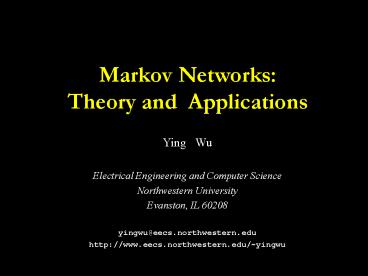Markov Networks: Theory and Applications PowerPoint PPT Presentation
Title: Markov Networks: Theory and Applications
1
Markov Networks Theory and Applications
Ying Wu Electrical Engineering and Computer
Science Northwestern University Evanston, IL
60208 yingwu_at_eecs.northwestern.edu http//www.eec
s.northwestern.edu/yingwu
2
Warm up
- Given a directed graphical model
- Prove
x2
x4
x1
p(x2x1)
x5
p(x1)
p(x4x2,x3)
p(x5x4,x6)
p(x3)
x6
x3
p(x6x3)
3
Wake up !
- Given a HMM p(ZiXi) and p(XtXt-1)
- Prove
4
Interesting problems (i)
- Super-resolution
- Given a low-res image, can you recover a high-res
image? - To make it feasible, you may be given a set of
training pairs of low-res and high-res images.
5
Interesting problems (ii)
- Capturing body motion from video
- Given a video sequence, you need to estimate the
articulated body motion from the video.
6
Outline
- Markov network representation
- Three issues
- Inferring hidden variables
- Calculating evidence
- Learning Markov networks
- Inference
- Exact inference
- Approximate inference
- Applications
- Super-resolution
- Capturing body articulation
7
Representations
- Undirected graphical models
- G(V, E), v ?V represents a random variable x, e
?E indicate the relation of two random variables - Each r.v. xi has a prior ?i(xi)
- Each undirected link (between xi and xj) is
associated with a potential function ?ij(xi, xj) - v?V, N(v) means the neighborhood of v
- We can combine undirected and directed graphical
models.
8
Markov Network
Undirected links
Directed links
9
Three issues
- Inferring hidden variables
- Given a Markov network ?
- To infer the hidden variable of the evidence
p(XZ, ?) - Calculating evidence
- Given a Markov network ?
- To calculate the likelihood of the evidence p(Z
?) - Learning Markov networks
- Given a set of training data Z1,,Zn
- To find the best model
10
To be covered
- The inference problem is the key among the three
- Why?
- Lets discuss
- We will focus on inference in this lecture
11
An example
- Given the above model, with
- p(zixi), ?i(xi)
- ?12(x1,x2), ?23(x2,x3), ?34(x3,x4), ?45(x4,x5),
?46(x4,x6) - To solve
- p(x3z1,z2,z3,z4,z5,z6)
12
An example
message x2 ? x3
message x4 ? x3
13
What do we learn from the Ex.?
x5
M54(x4)
x6
x3
x4
x1
x2
M64(x4)
M12(x2)
M23(x3)
M43(x3)
z3
z5
z1
z2
z4
z6
14
What do we learn from the Ex.?
15
Sum-Product Algorithm
xi
?ik(xi, xk)
xk
Message passing
Mki(xi)
zk
16
Properties
- Properties of belief propagation
- When the network is not loopy, the algorithm is
exact - When the network is loopy, the inference can be
done by iterating the message passing procedures
- In this case, the inference is not exact,
- and it is not clear how good is the approximation.
17
Application Super-resolution
- Bill Freeman (ICCV99)
- X high-frequency data
- Z mid-frequency data
- scene the high-frequency components
- evidence the mid-freq of the low-res image
input - The scene is decomposed by a network of scene
patches and each scene patch is associated with
an evidence patch - Learning p(zx) from training samples
scene patch
evidence patch
18
Results (Freeman)
actual high-res
actual high-freq
Iteration of B.P. to obtain high-frequency data
Recovered high-res image
Low-res input
19
Results (Freeman)
Training data
20
Variational Inference
- We want to infer
- It is difficult, because of the networked
structure. - We perform probabilistic variational analysis
- The idea is to find an optimal approximation
of - , such that the Kullback-Leibler
(KL) divergence of these two distribution is
minimized
21
Mean Field Theory
- When we choose a full factorization variation
- We end up with a very interesting result a set
of fixed point equations - This is very similar to the Mean Field theory in
statistical physics.
22
Computational Paradigm
- Three factors affect the posterior of a node
- Local prior
- Neighborhood prior
- Local likelihood
23
Application body tracking
- Capturing body articulation (Wu et al.)
- X the motion of body parts
- Z image features (e.g., edges)
- The motion of body parts are constrained and
correlated - Specifying ?(xi,xj)
- modeling p(zx) explicitly
24
Dynamic Markov Network
25
Mean Field Iterations
- We are still investigating the convergence
property of mean field algorithms - But our empirical study shows that it converges
very fast, generally, less than five iterations.
26
Application body tracking
27
Application body tracking
28
Summary
- Markov networks contain undirected edges in the
graph to model the non-casual correlation - Inference is the key of analyzing Markov networks
- Exact inference
- Approximate inference
- Two inference techniques were introduced here
- Belief propagation
- Variational inference
- Two applications
- Super-resolution
- Capturing articulated body motion

